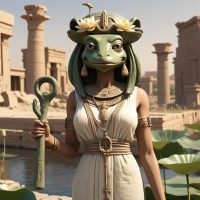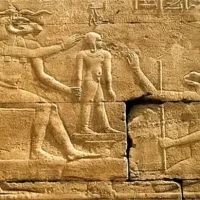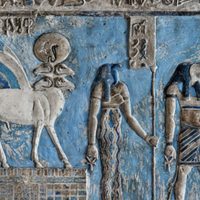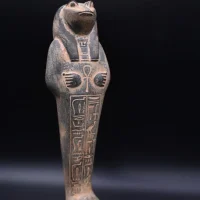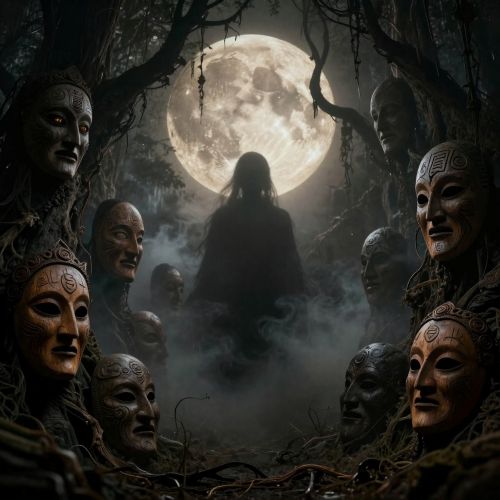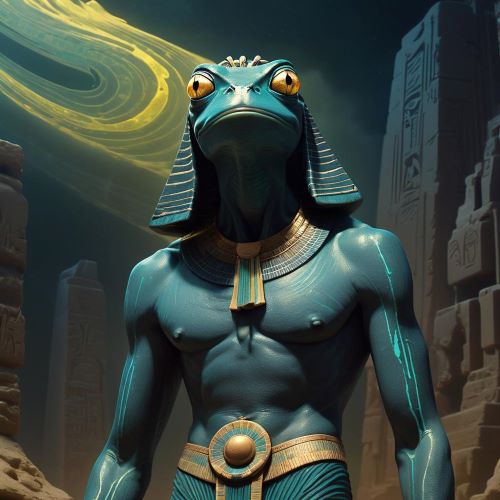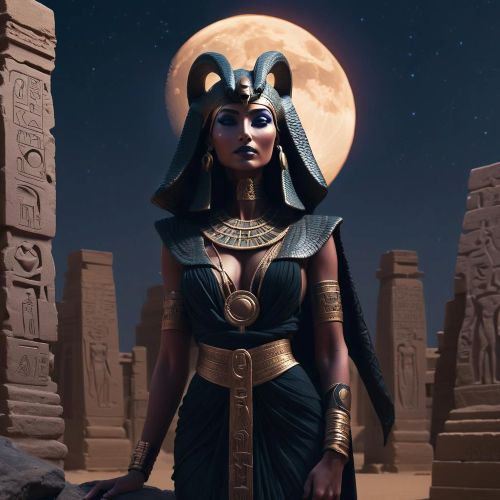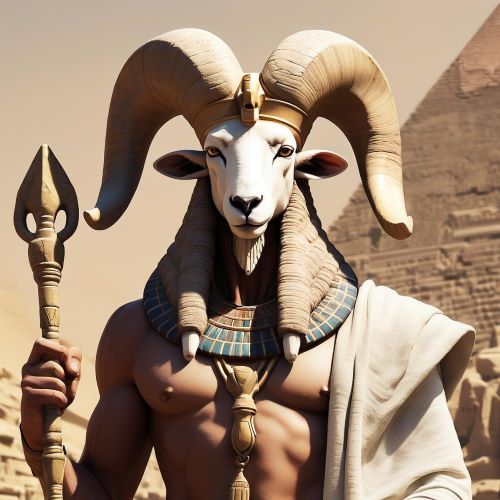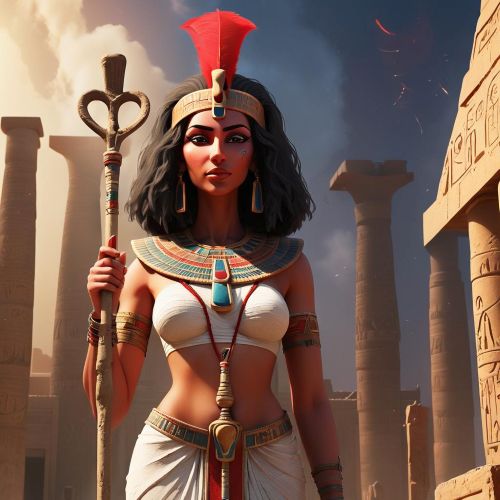Heqet : The Frog Goddess
Listen
At a glance
| Description | |
|---|---|
| Origin | Egyptian Mythology |
| Classification | Gods |
| Family Members | N/A |
| Region | Egypt |
| Associated With | Fertility, Birth, Renewal |
Heqet
Introduction
In the vast landscape of Egyptian mythology, Heqet (also known as Heket, Heqat, or Heqtit) is celebrated as a divine embodiment of fertility, childbirth, and renewal. Her origins trace back to Egypt’s earliest religious traditions, when life and nature were deeply intertwined with the Nile’s rhythm. The frog, her sacred symbol, became a powerful metaphor for rebirth and transformation, reflecting how new life emerged from the fertile floods that rejuvenated the land each year. As the midwife of the gods, Heqet represented the vital moment when potential became existence—the divine spark of breath that animated creation itself.
Physical Traits
Heqet’s depiction as a frog or as a woman with the head of a frog was not merely artistic symbolism but an expression of Egypt’s deep ecological awareness. Frogs appeared in great numbers after the inundation of the Nile, signaling renewal and abundance. This natural phenomenon reinforced Heqet’s identity as a goddess of life and regeneration. In many temple reliefs, she is seen holding the ankh, the symbol of eternal life, extending it toward newborns or pharaohs to grant vitality and divine legitimacy. The frog’s dual nature—living in both water and on land—reflected Heqet’s power over transition, symbolizing the passage from womb to world, from death to rebirth. Her image on amulets, furniture carvings, and birth wands made her a constant presence in both domestic and ritual spaces, ensuring protection and prosperity for families and mothers-to-be.
Family
Heqet’s divine partnerships reveal her integral role in Egypt’s theology of creation. She was most closely linked to Khnum, the ram-headed god who molded human beings from clay on his potter’s wheel at Elephantine. Together, they formed a divine pair—Khnum shaping the physical body, and Heqet breathing the essence of life into it. This sacred act symbolized the complete process of creation, blending craftsmanship with spiritual vitality. Some traditions describe Heqet as the mother or divine nurse of Horus the Elder, strengthening her association with birth and protection. In other regional myths, she was connected to deities like Heh, the god of infinity, or even Hathor and Nut, reflecting how her nurturing essence extended across different divine roles. These varying familial ties highlight her adaptability and her central place in the Egyptian understanding of how life begins and renews itself.
Other names
Throughout Egypt’s long history, Heqet’s name appeared in multiple forms, including Heqtit, Heket, and Heqat. These variations stemmed from regional dialects and evolving hieroglyphic traditions, but they all pointed back to the same life-giving goddess. Linguists suggest that her name may share roots with the word “heqa”, meaning “ruler” or “scepter,” indicating her authority over the domain of life itself. This linguistic link underscores her role as both a maternal and sovereign figure—a divine ruler over the mysteries of birth and regeneration. Interestingly, some scholars have even proposed a distant linguistic connection between Heqet and the Greek goddess Hecate, both figures sharing associations with female power, magic, and the threshold between worlds. While this theory remains speculative, it illustrates how Heqet’s influence may have transcended Egypt’s borders through cultural diffusion in later antiquity.
Powers and Abilities
Heqet’s powers were intimately connected to creation and the sacred process of giving life. She was believed to breathe the ka, or life force, into the bodies sculpted by Khnum, animating their spirit before birth. This made her not just a goddess of fertility, but the divine midwife who governed the moment when the physical and spiritual met. Women in labor invoked her name for protection, and midwives were considered her earthly representatives. Amulets in the shape of frogs were placed near expectant mothers or newborns to safeguard them from harm and ensure vitality.
Her influence extended beyond the birthing chamber into the realm of resurrection. In funerary texts, particularly the Pyramid and Coffin Texts, Heqet is depicted assisting in the rebirth of Osiris, symbolizing her command over both physical and spiritual renewal. She represented the cosmic cycle of death and regeneration that sustained Egyptian beliefs about the afterlife. One of the most vivid literary accounts of her divine role appears in the Westcar Papyrus, where Heqet aids in the miraculous births of the future kings of Egypt’s Fifth Dynasty. Her participation in these royal births demonstrates her importance not only in domestic life but in the divine legitimacy of kingship itself.
Modern Day Influence
Though the worship of Heqet gradually declined after the spread of Christianity and Islam in Egypt, her legacy continues to thrive in art, scholarship, and modern spirituality. The frog, her sacred emblem, remains a universal symbol of transformation and fertility, representing the rhythms of life and nature. Egyptologists continue to uncover amulets, carvings, and temple inscriptions that attest to the widespread devotion she inspired. Museums across the world often highlight Heqet as an example of how natural observation shaped divine symbolism in ancient religion.
In modern interpretations, Heqet has also been reimagined through the lens of feminist spirituality and ecological awareness. Contemporary spiritual movements, including Kemetic reconstructionism and neopaganism, revere her as a goddess of birth, healing, and natural cycles. Her image appears in rituals celebrating renewal and feminine strength, and she has become a symbol of empowerment for women reclaiming ancient goddess traditions.
Heqet’s symbolic connection to the frog also carries environmental resonance today. As amphibians are sensitive indicators of ecological health, modern interpretations view Heqet as a reminder of nature’s fragility and the sacred duty to protect life in all its forms. Artists and writers have drawn on her dual role as mother and restorer to explore the balance between creation and destruction, echoing the eternal cycles of the Nile.
In popular culture, Heqet appears in books, video games, and educational series on Egyptian mythology, often depicted as a benevolent force of life and renewal. Her influence even finds echoes in unexpected places—such as the internet’s fascination with frog symbolism—where the ancient association between frogs, rebirth, and mysticism subtly persists.
Related Images
Source
Britannica. (2023, October 19). Heqet | History, Egyptian goddess, frog, & facts. Retrieved from https://www.britannica.com/topic/Heqet
Ancient Egypt Online. (2020, May 31). Heqet. Retrieved from https://ancientegyptonline.co.uk/heqet/
Kids Britannica. (n.d.). Heqet – Students Encyclopedia. Retrieved from https://kids.britannica.com/students/article/Heqet/311661
Wikipedia. (n.d.). Heqet. Retrieved from https://en.wikipedia.org/wiki/Heqet
Ancient Egypt Tours. (2024, November 5). Heket: Frog goddess of fertility. Retrieved from https://ancientegypttours.com/heket-frog-goddess-of-fertility/
Zelazko, A. (Ed.). (2023). Heqet. In Encyclopaedia Britannica Online. Britannica Group.
Smith, J. (2020). Ancient Mythologies and Their Influence on Literature. Oxford Classical Studies Journal, 15(4), 112–128.
Wilkinson, R. H. (2003). The Complete Gods and Goddesses of Ancient Egypt. Thames & Hudson.
Frequently Asked Questions
What is lorem Ipsum?
I am text block. Click edit button to change this text. Lorem ipsum dolor sit amet, consectetur adipiscing elit. Ut elit tellus, luctus nec ullamcorper mattis, pulvinar dapibus leo.
What is lorem Ipsum?
I am text block. Click edit button to change this text. Lorem ipsum dolor sit amet, consectetur adipiscing elit. Ut elit tellus, luctus nec ullamcorper mattis, pulvinar dapibus leo.
What is lorem Ipsum?
I am text block. Click edit button to change this text. Lorem ipsum dolor sit amet, consectetur adipiscing elit. Ut elit tellus, luctus nec ullamcorper mattis, pulvinar dapibus leo.
What is lorem Ipsum?
I am text block. Click edit button to change this text. Lorem ipsum dolor sit amet, consectetur adipiscing elit. Ut elit tellus, luctus nec ullamcorper mattis, pulvinar dapibus leo.
What is lorem Ipsum?
I am text block. Click edit button to change this text. Lorem ipsum dolor sit amet, consectetur adipiscing elit. Ut elit tellus, luctus nec ullamcorper mattis, pulvinar dapibus leo.


